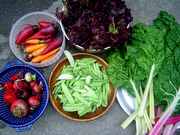

|
| Vegetable Varieties for Gardeners is a citizen science program
|
|
|
|
'Snapper' Peppers |
| |
| Sub-Category: |
Sweet
|
| |
|
| Sub-Category 2: |
| | Description: |
Hybrid sweet pepper. Plants bear blocky, 3- to 4-lobed, green fruit that ripen to red. Widely adapted. Resistant to bacterial leaf spot 1, 2, 3, pepper mottle virus, tobacco etch virus and tobacco mosaic virus.
|
| Days To Maturity: |
62-82
|
| Seed Sources: |
|
| |
| Rating Summary |
| |
Overall: (5.0 Stars)
Taste: (5.0 Stars)
Yield: (5.0 Stars)
Ease/Reliability: (5.0 Stars) |
| |
| Reviews |
| |
Login to share your Review of Snapper.
Number of Reviews: 2
KEY: O=Overall Rating, T=Taste, Y=Yield, E=Ease
Reviewed on 09/06/2017 by
bst
- An experienced gardener
|
 Overall Overall
 Taste Taste
 Yield Yield
 Ease Ease
|
Strafford, New Hampshire, United States
Frost Free Season: 143 - 163 days
Soil Texture: Loam
Garden Size: Small - Less than 400 square feet (20' x 20')
Sun Exposure: 6 to 8 hours per day
|
| Have planted these for several years now and have had great success with them. Easy to grow and produce an abundant crop of large. blocky fruits over a long period. Peppers can be tough to grow in New Hampshire, but these have done exceptionally well in dry, hot summers as well as in cool, wet summers. They produce right up until frost and freeze very well. However, seeds are getting hard to find. Found them this year only at Park Seed.\r\nSEPTEMBER 2019 UPDATE: Despite a wet spring and a very hot summer, these finally came around and produced another bumper crop. Mid-September and I still have something like 30 peppers on 6 plants. |
| |
|
Reviewed on 12/06/2013 by
bstnh1
- An experienced gardener
|
 Overall Overall
 Taste Taste
 Yield Yield
 Ease Ease
|
Strafford, New Hampshire, United States
Frost Free Season: 103 - 123 days
Soil Texture: Loam
Garden Size: Medium - 400 square feet to 1,600 square feet
Sun Exposure: 6 to 8 hours per day
|
| Tried this for the first time in 2013. Had great success - in fact it was my first successful attempt at growing a decent pepper. However, the few that I left to turn red, never did. Other than that, they were great for stuffing and freezing.
Grew them again in 2014 and had a bumper crop! Some plants had as many as 12 large peppers. |
| |
|
|
|
|
Vegetable Varieties for Gardeners is a citizen science program, © 2004-2024, All Rights Reserved
Cornell Garden Based Learning, Cornell University College of Agriculture & Life Sciences, Horticulture Section
|






 VVfG home
VVfG home


